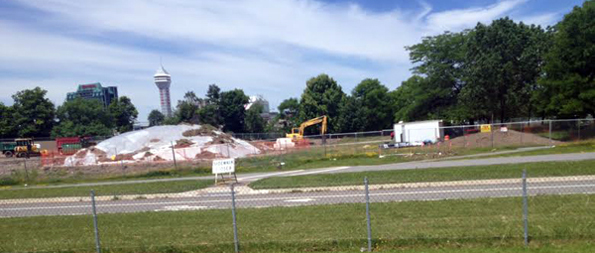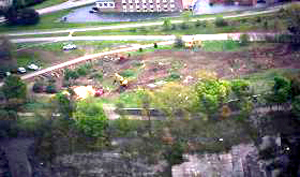|
| (Above) What the site of the proposed police barracks looked like before State Parks "improved” it. (Below) After State Parks improved and “cleaned up” site. |
 |
|
|
|
|
Like Ringo Starr sang at Artpark a couple of weeks ago, "It Don't Come Easy".
Nothing, it seems, comes easy when dealing with state agencies. With regards to rethinking the location of the State Parks Police barracks planned to be located at the top of the Niagara Gorge, it took numerous voices, of citizens, elected officials and the city tourism committee, raised in unison against the ill-advised project.
The effort was well worth it.
State parks spokesman, Randy Simons confirmed Friday that the parks decided to select another location for the police barracks - a 1.25-acre site on the east side of the Robert Moses Parkway.
The open space on the gorge rim, previously intended for the new police station, will now become part of a world-class Niagara Gorge park upon completion of "Phase One" of north Robert Moses Parkway removal.
This is also an excellent precedent for an upcoming request we will be making of State Parks: simultaneous with removal of the Parkway overpass, the State Parks maintenance garage next to the Whirlpool Bridge, like the barracks, should also be moved off the gorge rim and into the city.
The past few weeks would not have been so stressful for everybody concerned had state parks been more open and transparent about its plans. Notices of meetings in the press and elsewhere that supposedly addressed the construction plans had to have been the minimum necessary, because no one seems to remember anything about notices or meetings except one single individual we could find who preferred not to be named. That individual told us that one slide had been snuck in at the very end of a presentation about something else State Parks wanted to do at a meeting that was very sparsely attended.
Did you hear anything about an public hearing with regards to situating the barracks on the gorge? Neither did we, and as our readers know, this paper keeps track of State Parks doingses, like a dog keeps track of a meatball.
There were some interesting aspects of the announcement to not build the police barracks at its intended site. For example, Regional Economic Development czar Sam Hoyt was quoted in the Buffalo News as saying, "The people spoke. We wish they had spoken more loudly earlier."
|
|
| (Left) (A): State Parks maintenance garage, taking up valuable gorge top. (B) Robert Moses Parkway (to be removed) (C): Whirlpool St. (D): Old Custom House. The Reporter is calling upon State Parks to relocate its garage now that the Parkway is being removed to open up valuable gorge access. |
|
|
|
|
Of course, Mr. Hoyt, most would have, had any known before the Niagara Falls Reporter first broke the story on May 27. Prior to the Reporter telling the public that a police barracks was planned on pristine gorge property, no one knew.
Over the next few days after we published our story, after fervent, behind-closed-doors discussions, other media followed and the whole of Niagara Falls government and citizenry rallied and spoke with one voice in favor of halting construction and reconsidering the location.
Hoyt added, "It’s a good outcome when it comes to addressing the very real sensibilities of people who are concerned about the gorge … It isn’t frivolous. It isn’t unjustified, and we are changing course," even though Empire State Development, the state development arm of Gov. Cuomo of which Hoyt is Regional President, really had nothing to do with situating the building on the gorge.
Just letting everybody know who calls the shots around here, people.
And in a final grasp at justifying the cutting down of 52 mature hardwood trees and bulldozing of a previously unspoiled portion of Niagara Gorge parkland, parks spokesman Simons said, "The good news is that the gorge site is now cleaned up, which eventually would need to be done anyway."
Why did forested, green and pristine parkland need to be "cleaned up"?
Is there a danger of children or pets eating subsurface dirt there?
We believe that the relationship between State Parks and the city of Niagara Falls is entering a new historical era, one in which the previously aloof and autocratic agency will henceforth give a little more consideration to the opinions and aspirations of the folks who actually live here and whose lives are impacted by its policies and practices.
In some small way, this newspaper helped to bring them there.
|




